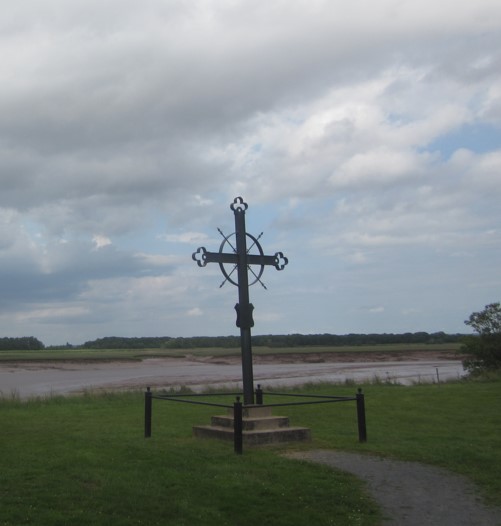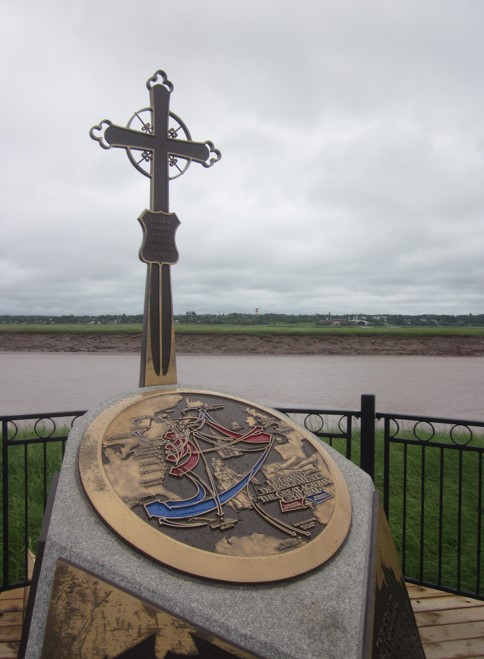See Part II here.
The appointment of a professional soldier like Edward Cornwallis, with a mission to build, settle, and develop Nova Scotia, announced a new British seriousness in a colony that the metropole had long neglected. The new governor proved scornful of the past management of the colony and he sought to assert his will and gain the compliance of the Acadians in his designs. In a proclamation dated July 1749, Cornwallis restated the clauses of the Treaty of Utrecht and pledged to protect Acadians’ property so long as they swore the oath of allegiance. In no time, Acadian deputies from the northwestern part of Nova Scotia made representations to the colonial council and expressed a willingness to take the oath so long as they were exempted from taking up arms, which the council rejected. In other words, the conditional oath was now history. Two months later, deputies delivered a petition bearing a thousand names; it might have been written thirty years prior, for it again expressed fear of Native reprisals, a desire to enjoy their property unmolested, and a willingness to leave if the council did not uphold the conditional oath. The next year, Cornwallis provided a more extensive response. He explained that
your determination to leave gives us pain. We are well aware of your industry and your temperance, and that you are not addicted to any vice or debauchery. This province is your country; you and your fathers have cultivated it; naturally you ought yourselves to enjoy the fruits of your labour. Such was the design of the King our master. You know that we have followed his orders. You know that we have done everything to secure to you not only the occupation of your lands, but the ownership of them forever.
It makes sense. The departure of the Acadians would entail a loss of wealth for the colony and potentially open up space for the supposed machinations of the Native people. Those who left might also simply reinforce the French. No less, Cornwallis was willing to let families leave as long as they first requested a passport from the council and accepted the transportation arranged for them—a compromise.

Accommodation endured because of the uneasy military position of the British. Cornwallis was butting up against the old challenge of asserting British authority without causing an Acadian backlash. He was also spared pressure from Shirley. In 1748, Mascarene had briefed Shirley at length about the history and the situation of British-held Acadia, which had enabled Shirley to mold imperial policy further. Yet, Cornwallis’s time at the head of Nova Scotia coincided with Shirley’s leave of absence from Massachusetts, such that the former did not feel compelled by his more influential compatriot to carry out his designs. This mild regime—mild in its practices more than in its intents—continued under another governor, Peregrine Hopson, after Cornwallis’s short tenure. The Hopson years also matter because, Faragher notes, they were “an important [interlude], if only as a demonstration that there was nothing inevitable about the subsequent course of events. The removal of the Acadians would not be determined by inexorable forces or ancient hatreds, but by the immediate choices made by men” (277).
I mentioned the absence of a stable peace. In the late 1740s and into 1750s, two governors of New France, the marquis de la Galissonière and the marquis de la Jonquière, pursued an aggressive policy of French encirclement and fort construction, which stretched into the disputed frontier of northwestern Nova Scotia. From their perch in Quebec, these governors might not have understood that the Acadians would pay the price for rising tensions in Nova Scotia. Such tensions spilled into relations between the Native population and the Acadians. By the early 1750s, it was apparent to all that these two groups were pursuing different agendas. The Acadians genuinely sought to stay aloof of imperial conflicts. By contrast, the Mi’kmaq partnered with other Indigenous groups to attack the British at Minas in 1749, officially a period of peace. They took nineteen prisoners. They also seized Acadian notary René Leblanc, who approved of Anglo-Acadian compromise.
Father Jean-Louis Le Loutre, a Catholic priest, helped secure and maintain ties between French colonial authorities and the Mi’kmaq. Le Loutre was also contemptuous of the Acadians who, in his view, were not doing their proper duty to move to French dominions and serve the French crown. When the infamous Charles Lawrence marched on the Beaubassin area in 1750, it wasn’t British forces that burned Acadian homes, but French soldiers acting on orders of a French captain and Father Le Loutre; their purpose was to force Acadian farmers back behind French lines. Under orders of the governor of New France, local officers sought to extract an oath of allegiance to the French king from the displaced Acadians. They, “no less than the British[,] insisted on the absolute loyalty of their subjects” (Faragher, 270). The officers were met by familiar reticence.
We could develop an entire course on the events of the early 1750s. Here I want to emphasize the security concern that led to the break in the tenuous system of accommodation. The events in Minas and Beaubassin are but a few instances of a spiraling conflict. In fact, it appears that the Acadian families that moved to Ile Saint-Jean in the early 1750s were not suddenly coming to their senses and recognizing French authority, but quite simply fleeing a war zone. In Halifax, Governor Hopson recognized that most Acadians did not want to leave their homes and settlements; at the same time, he worried that those who left did in fact go to the French side rather than New England. In 1752 and 1753, a lull enabled Hopson to focus on political disputes in Halifax and on the establishment of new immigrants in Nova Scotia, at Lunenburg, for example. Yet, while this was happening, France and Britain were nearing war in other theaters. Famously, in 1754, a young George Washington marched his troops into the Ohio River region to reassert Virginia’s claim. This led to frontier skirmishes. A larger clash seemed both inevitable and impending. Each side would again want to strike first while avoiding the mistakes of the prior war, which had ended less than six years earlier. Both sides would again scrutinize Acadians’ loyalties.

The risk of conflict and the return of an assertive William Shirley combined with another event to make Acadians’ situation untenable. That event was Charles Lawrence’s appointment as Nova Scotia’s lieutenant governor. Lawrence had the same security preoccupations as his predecessors, but, unlike them, he never viewed the Acadians as British subjects. The tone of his letters is in fact markedly different. In 1754, he highlighted the Acadians’ “obstinacy, treachery, partiality to their own Countrymen, and their ingratitude for the favor, indulgence and protection they have at all times so undeservedly received from His Majesty’s Government.” To the Lords of Trade, he noted how many had gone to Beauséjour, behind French lines, to build dykes, without ever receiving passes. He may have conveniently ignored the fact that the French had forced the Acadians into these corvées—a type of impressment. But the result was the same. Unable to rely on this settler population at a time of war, he resolved to put an end to the apparent leniency of British policy.
In the winter of 1754-1755, Lawrence and Shirley, whose fighting men were essential to all operations, plotted an offensive in the Chignecto region. This was done quickly. The French forts of Beauséjour and Gaspereau fell in June 1755. This closed a channel of communication between the French and the Acadians. Further pleading by Acadian deputies, who understood the growing pressure placed on them by Halifax, in the summer of 1755, proved futile. On July 3, the council refuted Acadian claims one by one and underlined every instance of cooperation with metropolitan France as could be found. The council asked the deputies to accept an unconditional oath on behalf of their entire people; they refused to do so without first consulting their people. The council gave them twenty-four hours to reconsider. The deputies returned with the same answer. Authorities cited an English statute “whereby Persons who have once refused to Take the Oath cannot be afterwards permitted to Take [it],” and the deputies were “ordered into confinement.”
This situation repeated itself on July 28, 1755, when a new delegation arrived. It was on that day, in the wake of this refusal to accept the oath, and having secured the northweastern section of Nova Scotia, that Lawrence and the council resolved on the removal of the Acadians. “[T]o prevent as much as possible their Attempting to return and molest the Settlers that may be set down on their Lands,” the council unanimously resolved, “it would be most proper to send them to be distributed amongst the several Colonies on the Continent, and that a sufficient Number of Vessels should be hired with all possible Expedition for that purpose.” This would have to be carried out quietly to prevent the Acadians from fleeing to the French side, a paramount concern of the prior forty years.

We know well what followed. Quite fairly, Griffiths reminds us that there were precedents to the removal of these “French neutrals.” She writes that “by the middle of the eighteenth century, British authorities . . . were accustomed to transporting a motley collection of subjects, under varying regulations, from one jurisdictional area of the realm to another” (443-444). Lawrence was not an innovator in that regard. However, I do not see in the eighteenth century a forced removal of this scale, a deportation of such tragic proportions that entailed the thorough decimation of a people. A community of 14,000 people was wiped from the map. Some escaped; the majority were placed on ships for destinations they knew little about. Others faced imprisonment in Nova Scotia. As cruel as the deportation order was, it was somehow surpassed by the implementation: resorting to ships that were barely afloat; sending the Acadians to colonies that refused them and extended their suffering; failing to provide adequate sustenance; and the list goes on and on. Truly, we cannot say enough of the resilience of the Acadians who suffered, survived, and rebuilt as best they could. Still today, their diasporic communities stand as a monument to the cruelty and to the failure of humanitarianism that resulted from the Nova Scotia council’s decision on July 28, 1755.
To summarize, the Acadian experience between 1713 and 1755 consistently evinced signs that accommodation could occur. That this era overlapped with a lengthy peace while the deportation occurred at a time of war is no coincidence. Though it is easy to imagine the removal as an act of imperial strength, British decision making in Nova Scotia occurred consistently from a position of weakness. This colony was on the margins of the empire but also on the margins of imperial thinking. British weakness benefitted the Acadians in peacetime; it left them in a precarious position in times of war. In either case, compromise was often essential. Although not without prejudice, governors sought to make this colonial experiment work. In a slightly different world, an experiment that lasted over forty years might have endured yet longer. Alas, the Acadians of the Maritime region were swept up in imperial rivalries. Throughout these years, we find that Acadians did not fit any better in the imperial designs carried out by the French crown, nor did their interests coincide with those of Indigenous peoples. Thus, as a unique New World people eager to protect their independence, their rights, their faith, and their safety, the Acadians of colonial Nova Scotia were perhaps ahead of their time, foreshadowing political possibilities that only came later.
A Note on Sources
Primary evidence for this lecture is drawn from Selections from the Public Documents of the Province of Nova Scotia: Papers Relating to the Acadian French 1714-1755 and Papers Relating to the Forcible Removal of the Acadian French from Nova Scotia, 1755-1768, edited by Thomas B. Akins (1869), reproduced virtually on “Acadian Heartland: Records of the Deportation and Le Grand Dérangement, 1714-1768” by the Nova Scotia Archives. The Dictionary of Canadian Bibliography, also available online, served as a guide to the main political figures of colonial Nova Scotia. Recent scholarly surveys of the British period and the deportation include Geoffrey Plank, An Unsettled Conquest: The British Campaign Against the People of Acadia (2001); John Mack Faragher, A Great and Noble Scheme: The Tragic Story of the Expulsion of the French Acadians from Their American Homeland (2005); Naomi E. S. Griffiths, From Migrant to Acadian: A North American Border People, 1604-1755 (2005); and Christopher Hodson, The Acadian Diaspora: An Eighteenth-Century History (2012). The deportation is discussed and debated in Griffiths, ed., The Acadian Deportation: Deliberate Perfidy or Cruel Necessity? (1969). The Acadian Archives at the University of Maine at Fort Kent are home to a wide range of published works on eighteenth-century Acadians, including French-language materials.
Many descendants of Acadians managed to find land and homes in north of Maine – as noted in a book about Rumford Maine during recent years.
“We could develop an entire course on the events of the early 1750s.”
Yes!! Please, an Archive lecture at least. Fleeing a war zone is certainly a different image than just picking up and leaving for PEI.
Maybe the university would support a distance-learning course?